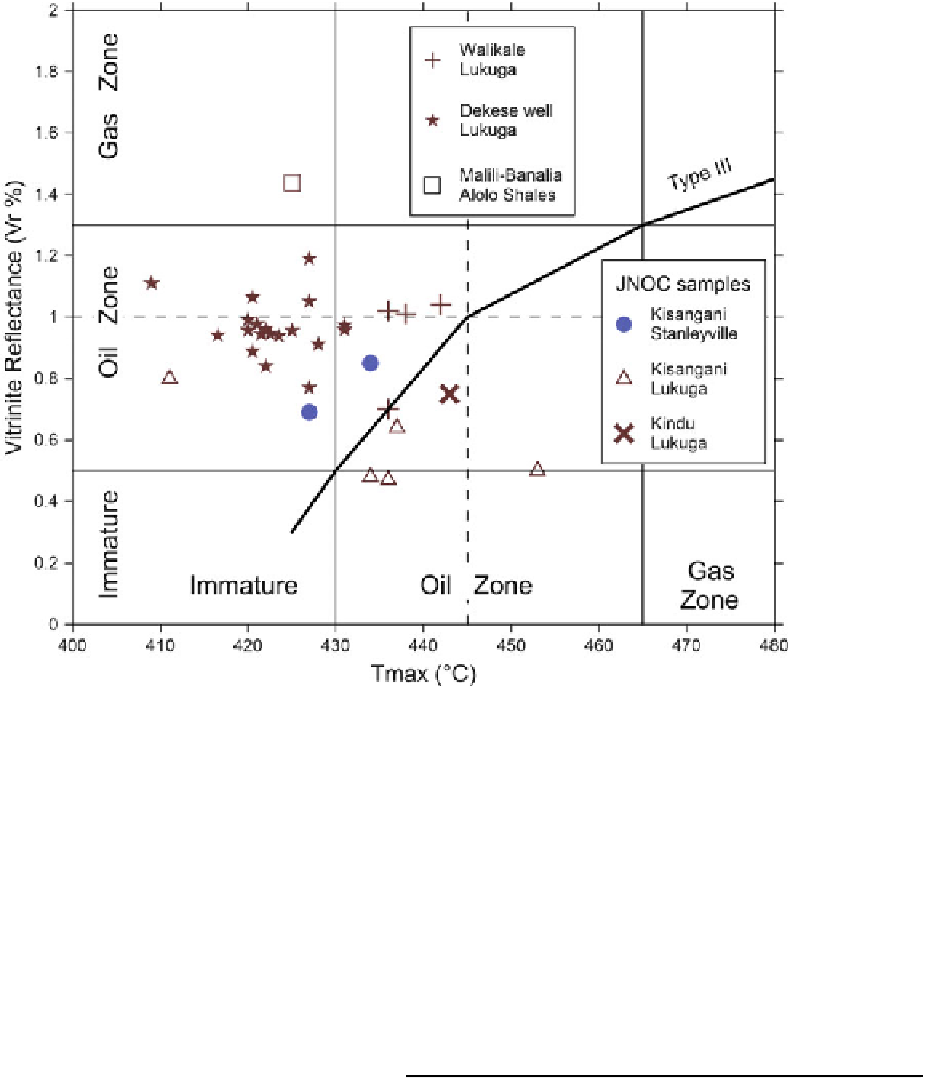Geology Reference
In-Depth Information
Fig. 18.5
Correlation between Tmax temperature and vitrinite reflec-
tance values.
Bold line
shows the ideal evolution path for type III
organic matter (Espitalie et al.
1977
; Espitalie
1986
). Most of the
Lukuga Group samples from the Dekese well appear anomalous, with
Vr value stoo high relative to Tmax. Data from Tables
18.1
and
18.2
the ideal evolution path constructed from literature data
(Espitalie et al.
1977
;Espitalie
1986
). With reference to this
evolution path, all the Dekese well samples display Vr values
too high relative to corresponding Tmax. Such a shift is not
seen for the other Lukuga samples (Walikale and Kisangani),
or for the Stanleyville samples. This may be explained by
contamination of the samples by recycled vitrinite, because
petrological observations (Sachse et al.
2012
) show that the
samples from the Lukuga Group contain large amount of
allochtonous vitrinite and vitrinite-like particles, mainly in
the Dekese well.
The presence of allochtonous vitrinite in the Lukuga
Group samples of the Dekese suggests that they have been
recycled, possibly eroded from Lower Carboniferous to
Upper Devonian rocks that may have been buried up to
3,000-4,000 m deep. Such rocks are not known in the CB,
but do occur farther South, in South Africa and Namibia (e.g.
Tankard et al.
2009
).
All dark shales and limestones from the Neoproterozoic
(Lenda carbonates of the Ituri Group, Mamungi shales of the
Lokoma Group, Bangu black limestone of the Schisto-Calcaire
Group) and the Lower to Middle Paleozoic sequences (Alolo
Shales of the Aruwimi Group) are barren or contain residual
organic matter; their maturity cannot be measured therefore
with the Rock-Eval Tmax. The Tmax values for those few
Alolo shales that are rich enough for a Rock-Eval analysis
(from the Yambuya section), are not significant because the
small amount of hydrocarbons generated during pyrolysis rep-
resent residual organic matter. These samples are also too old
(Precambrian) to contain vitrinite particles.
18.6
Reported Oil Seeps and Resource
Potential for Petroleum
Over the last 10 years several oil seeps have been reported
within the CB (Fig.
18.1
), although none of them have
been found by the exploration companies that studied
the basin in the 1950s and the 1970-1980s. They were
re-vis tedandsampledbetween2007and2008byHRT
Petroleum for analysing their biomarkers by GC-MS
(Gas-Chromatography-Mass spectrometry), GC-IRM and
diamontoids (Mello
2008
). HRT Petroleum concentrated their
investigations near Ilanga-Kole and Tolo along the Lukenie


Search WWH ::

Custom Search